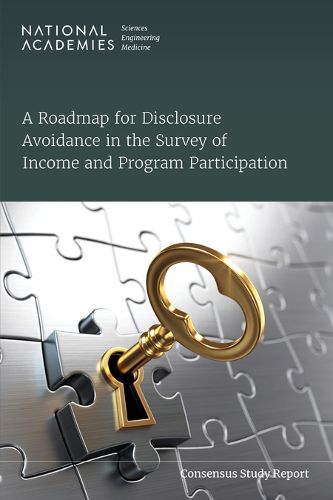A Roadmap for Disclosure Avoidance in the Survey of Income and Program Participation
National Academies of Sciences, Engineering, and Medicine, Division of Behavioral and Social Sciences and Education, Committee on National Statistics, Panel to Create a Roadmap for Disclosure Avoidance in the Survey of Income and Program Participation

A Roadmap for Disclosure Avoidance in the Survey of Income and Program Participation
National Academies of Sciences, Engineering, and Medicine, Division of Behavioral and Social Sciences and Education, Committee on National Statistics, Panel to Create a Roadmap for Disclosure Avoidance in the Survey of Income and Program Participation
The Survey of Income and Program Participation (SIPP) is one of the U.S. Census Bureau's major surveys with features making it a uniquely valuable resource for researchers and policy analysts. However, the Census Bureau faces the challenge of protecting the confidentiality of survey respondents which has become increasingly difficult because numerous databases exist with personal identifying information that collectively contain data on household finances, home values, purchasing behavior, and other SIPP-relevant characteristics.
A Roadmap for Disclosure Avoidance in the Survey of Income and Program Participation addresses these issues and how to make data from SIPP available to researchers and policymakers while protecting the confidentiality of survey respondents. The report considers factors such as evolving privacy risks, development of new methods for protecting privacy, the nature of the data collected through SIPP, the practice of linking SIPP data with administrative data, the types of data products produced, and the desire to provide timely access to SIPP data. The report seeks to balance minimizing the risk of disclosure against allowing researchers and policymakers to have timely access to data that support valid inferences.
Table of Contents
Front Matter Summary 1 Introduction 2 Overview: Survey of Income and Program Participation (SIPP) and Its Uses 3 Measuring of Disclosure Risk and Ways of Assessing It 4 Overview of Disclosure Limitation Approaches 5 Disclosure Limitation Approaches: Secure Online Data Access (SODA) 6 Disclosure Limitation Approaches: Synthetic Data 7 Disclosure Limitation Approaches: Flexible Table Generator and Remote Analysis Platforms 8 Disclosure Limitation Approaches: Geography Variables 9 Maintaining Usability While Preserving Confidentiality: Potential Strategies 10 Conclusions and Recommendations References Appendix A: Technical Details on Measuring Disclosure Risk Appendix B: Inferences Based on Multiple Synthetic Data Appendix C: Technical Details for Differential Privacy Table Builder Appendix D: Technical Details for Geography Variables Appendix E: Data Collection Report Appendix F: Sources Used for Figures 9-1 and 9-2 Appendix G: Biographical Sketches of the Panel Committee on National Statistics
This item is not currently in-stock. It can be ordered online and is expected to ship in approx 4 weeks
Our stock data is updated periodically, and availability may change throughout the day for in-demand items. Please call the relevant shop for the most current stock information. Prices are subject to change without notice.
Sign in or become a Readings Member to add this title to a wishlist.


